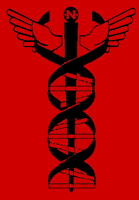

© Copyright 2000-2002, Robert A. Freitas Jr.
All rights reserved.
The vasculocyte, intended for use in the limited vascular repair of primarily intimal arteriosclerotic lesions, is a squat, hexagonal-shaped nanorobot with rounded corners, measuring 2.7 microns across and 1 micron talldesigned by Robert A. Freitas Jr. Its 400-billion atom structure weighs about 8 picograms. The device is scaled so that its longest cross-body diagonal is shorter than 4 microns, the diameter of the narrowest capillaries in the human body. The slightly-curved topmost surface is almost completely tiled with 174,000 molecular sorting rotors to allow rapid exchange of specific molecules between the interior of the nanorobot and the patient’s bloodstream.
On its six side walls the vasculocyte is enveloped by an extensible “bumper” surface which cycles between 100 nm and 300 nm of thickness as internally-stored piston-pumped ballast water inflates and deflates the surface about once every second. This cycling allows a nanorobot situated on an arterial wall to continuously adjust its girth by up to 15% to match the regular distensions of arterial wall circumference that occur during each systolic pulse of the heart. On its bottom face, the vasculocyte has 625 stubby telescoping appendages, each capable of 1 cm/sec movements. Limbs are 30 nm in diameter and 100 nm long, spaced out along a regular grid about 100 nm apart to avoid any possibility of collision. Only 10% of them are used at any one time, to preserve 10-fold redundancy. Each leg walks on a “footpad” tool tip that is 10 nm in diameter. Acting like a snowshoe, the footpad distributes leg motion forces widely enough to avoid disrupting cell membranes.